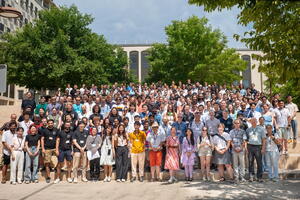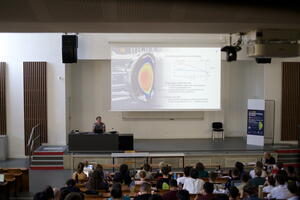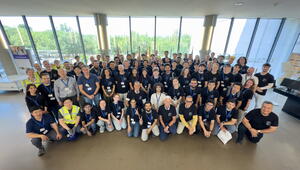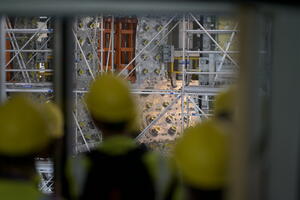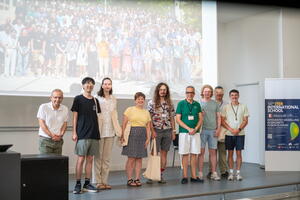On the integrated modelling of magnetic fusion plasmas
The 14th ITER International School concluded successfully in Aix-en-Provence, France, on 4 July 2025 after five days of lectures and discussions. More than 200 students and lecturers from 39 countries participated.
The 2025 ITER International School on integrated modelling of magnetic fusion plasmas was successfully held from 30 June to 4 July. The event gathered 232 participants from 39 different countries, representing a diverse and international community of experts in the field. The lectures were delivered by 17 prominent specialists in the integrated modelling of magnetic fusion devices. In line with the evolution of the fusion energy development panorama and with ITER Council guidance, 17 of the students and one lecturer were affiliated with privately funded fusion research initiatives.
The ITER International School was the fourteenth in the series, which alternates between sites within the ITER Member countries and Aix-en-Provence, France, close to where ITER is being constructed. This time the school took place in Aix-en-Provence, hosted by Aix-Marseille University (AMU). The venue was the Amphitheatre Guyon, Faculté d'Arts, Lettres, Langues et Sciences Humaines, which had very good conference facilities and was centrally located allowing participants to enjoy the lively city centre.
This year’s school focused on the integrated modelling of magnetic fusion plasmas. Reliable predictions of ITER plasmas, spanning the entire cross-section from the plasma core, the scrape-off layer, and up to the material surface are key to the achievement of ITER’s fusion power demonstration goals. These predictions are essential for defining and preparing plasma operational scenarios and analyzing plasma pulses that will be executed in ITER, as well as for evaluating the required control schemes through the simulations of measurements, actuators, and the associated plasma responses. Given the strong non-linear coupling of processes governing burning plasma behaviour, separate modelling of individual processes and/or plasma regions is not sufficient. A holistic, integrated approach is therefore mandatory. Lectures spanned a wide range of topics, from whole-fusion-device integrated modelling with a wide range of sophistication and computational cost to specific modelling of interlinked physics and control processes. These included edge-plasma physics/plasma-wall interactions, fast particle physics and magneto-hydrodynamic instabilities, etc., as well as flight simulators to cite a few examples. The application of artificial intelligence to facilitate integrated modelling was a recurring theme in some presentations this year as a promising way forward for this field. Exchanges between participants highlighted how the various approaches to integrated modelling can be used to address complex physics and control from the micro-scale/millisecond time scale to full-scenario simulations.
One of the highlights of the school was the visit to the ITER Organization, allowing school participants to see the progress in the construction of ITER and to learn more about ITER status and plans and how integrated modelling is being developed and applied to support the development and refinement of these plans.
The students had the opportunity to present their research work in two poster sessions. The quality of the work presented during the two poster sessions held at this year’s school was very high. The school lecturers along with the scientific committee selected three participants per poster session and awarded their outstanding research work with the presentation of several ITER “goodies” including a piece of ITER itself (a slide of poloidal field coil superconducting cable) for the first prizes of each session.
The students awarded the prizes were:
First prizes
• Ivan Kudashev from Aix-Marseille University, CNRS, Centrale Méditerranée, M2P2: “Synthetic diagnostics application for diagnostics design and confrontation of SolEdge-HDG 2D fluid integrated transport simulations with experiments”
• Fabian Solfronk from the Max-Planck-Institute für Plasmaphysik, Garching: "Expanding the Physics Modelling Capabilities of ASTRA from Core to SOL and from Tokamak to Stellarator Towards Application in a Multi-Device Flight Simulator"
Second prizes
• Veronika Korzueva from Peter the Great St.-Petersburg Polytechnic University: “SOLPS-ITER modelling with applied neoclassical corrections to the transport of impurities”
• Haley Wilson from Columbia University: “Using integrated modelling to explore the core operational space around a reactor-class negative triangularity tokamak”
Third prizes
• Theo Fonghetti from CEA Institut de Recherche sur la Fusion par confinement Magnétique: "Towards high performance long pulse operation with combined LHCD and ECCD in WEST”
• Hong-Sik Yun from Seoul National University: “Development of an Integrated Data Analysis Platform for the VEST Tokamak”
Overall, the 14th ITER International School was a resounding success, bringing together a diverse group of participants from around the world to exchange knowledge, share experiences, and foster collaboration on integrated modelling of magnetic fusion devices. The support from Aix-Marseille University (AMU) and, in particular, its Institute for Fusion and Instrumentation Sciences in Nuclear Environments (ISFIN), the ITER Organization, the Burning Plasma Organization (USA), the National Institute for Fusion Science (Japan), EUROfusion (EU), Fusenet (EU), the International Atomic Energy Agency, and the TULP Fusion Foundation greatly contributed to the success of this event.
The slides of the lectures will be available later this week on this ITER webpage together with the information on past ITER International Schools.

